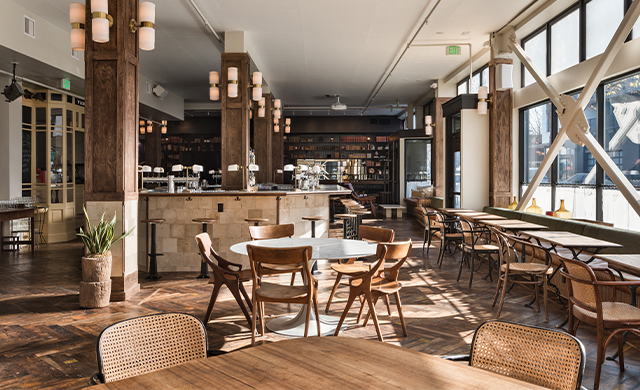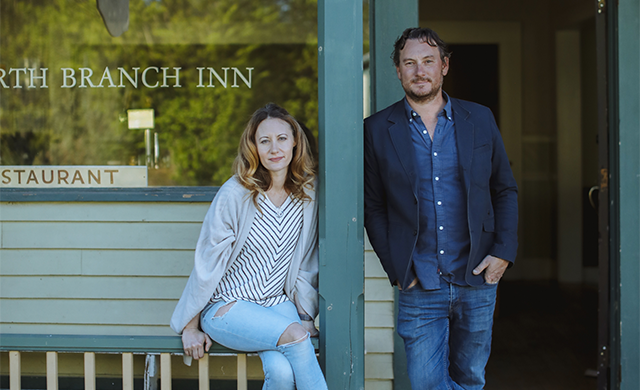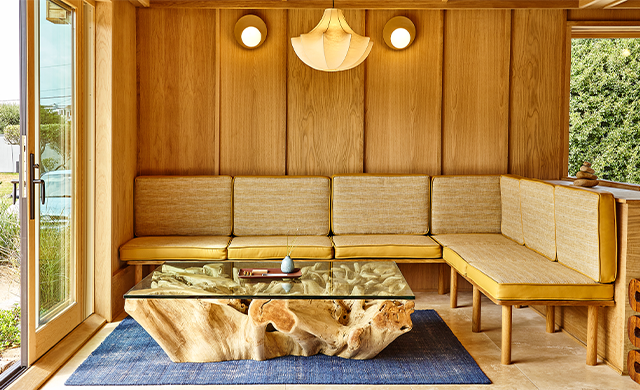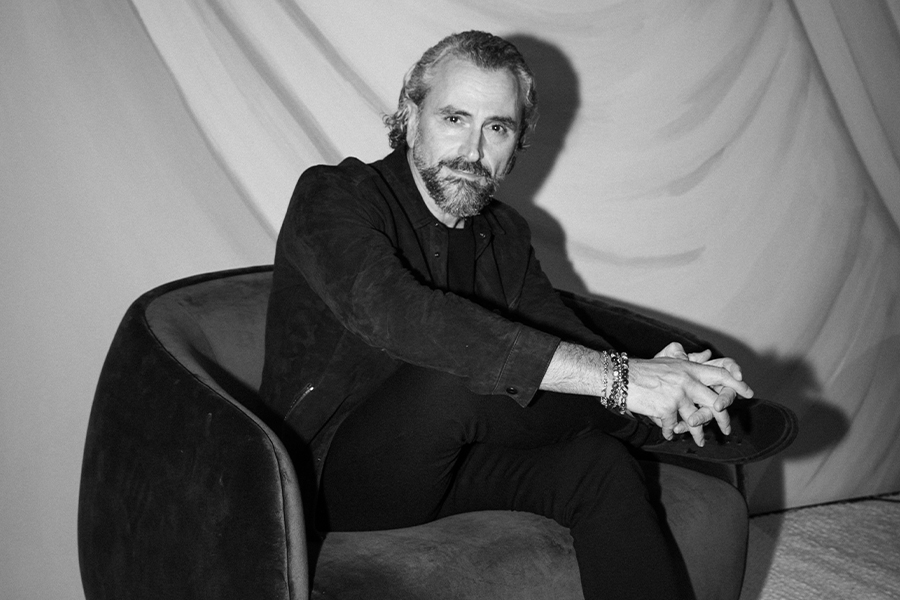Kristinn Vilbergsson
CEO, KEX Hostel
Kristinn “Kiddi” Vilbergsson opened the first KEX hotel in Reykjavik in 2011 to cater to the new Iceland tourist, someone “who was looking for experience first and wanted a great place to stay that was inexpensive and goodlooking,” he says. “That was the bedrock of our concept.” After its success, Vilbergsson—long eager to expand KEX to the West Coast of the U.S.—visited Portland, Oregon for the first time and was immediately smitten. “It felt like a sister city to Reykjavik in so many ways. I loved the community and culture—all the great food, beer, and wine. People care about what they do here and how it can improve the city,” he says.
Taking chances
In 2008, Iceland, like most of the world, was in the throes of financial collapse. But tourism, an industry that would ultimately help the country recover from its economic woes, was percolating. At the time, Vilbergsson was working for a production company and, alongside set designer Hálfdan “Dáni” Pedersen, was scouting buildings for a film. Plans for the movie were eventually scrapped, but Pedersen’s design treatment for one of the cinematic sites—a neglected biscuit factory in Iceland’s capital—sparked another idea: to transform the structure into a socially powered hostel. KEX, which debuted three years later, “was conceived and built during a time of crisis. It was done so by a group of friends looking for a way to invest in Reykjavik,” explains Vilbergsson. Transcending everyday notions of no-frills hostels, the inviting, bustling atmosphere, fueled by enticing F&B options, made KEX stand out.

Dóttir restaurant at KEX Portland employs natural materials such as stone and wood
West Coast dreams
Having moved to Vancouver, Canada in 2015, Vilbergsson took the train down to Portland to scout new locations for his emerging brand. The second KEX outpost arrived in 2019. Situated in a former apartment building in a Central Eastside neighborhood, KEX Portland thrives on communal spaces and a roster of art and music programming. “Hotels often feel like they stand in contrast to the community around them, that they are for outsiders. We disagree,” says Vilbergsson, who now splits his time between Portland and Iceland. The interiors are once again Pedersen’s handiwork, which Vilbergsson admires for “the sense of discovery in his designs.”
Elevated experience
To remake the hostel model as something refined yet affordable, Vilbergsson markets to the experience-driven modern traveler. “Even though [our guests] may be in a shared room,” he says, “they can expect a boutique hotel experience from start to finish.” It’s one of the reasons he emphasizes community and comfort in the public spaces. Consider Dóttir, KEX Portland’s ground floor restaurant. Inspired by the European lobbies of yore, an earthy wood- and stone-bedecked bar attracts more locals than tourists. Between the Icelandic-meets-Pacific Northwest menus and ample library-like areas to hang out in, Dóttir, says Vilbergsson, is “a subtly elegant yet accessible restaurant that we hope feels like home from the moment you sit down.”
Kirsten Harlow Foster and Sims Foster
Cofounders, Foster Supply Hospitality

Husband-and-wife team Sims and Kirsten Harlow Foster founded Foster Supply Hospitality (FSH) in 2016 with a goal to bring the Upstate New York Catskills region, where Sims was born, back to its midcentury glory days when families would flock to the quaint resort area as a respite from the city. With extensive F&B experience, having cut his teeth with the likes of Commune Hotels + Resorts and Denihan Hospitality, Sims says FSH was an opportunity to go back “to a more balanced approach to hospitality at a scale where we feel we can change the trajectory of a guest’s day, week, or even perhaps life.”
Hospitality, adds Kirsten, “is in our blood. It is part of our history, and it is our way forward.” The first of their life-changing projects was the cozy 14-room Arnold House inn and tavern, which led to four additional small-key properties, all restorations that nod to the architectural and emotional heritage of the area.
Quiet oasis
After marrying, “we had a strong desire to return to our roots in the Catskills, where we wanted to contribute to a much-needed and deserved rebirth of our area,” Kirsten says. Their second property, the 14-room North Branch Inn, debuted 18 months after the Arnold House and exemplifies their focus on rehabbing dilapidated buildings in the region. “We consider our properties to be launching pads from which to discover the area,” notes Kirsten. North Branch Inn’s refurbished century-old building is now resplendent in historical details and Americana, and it was enough to give the duo the momentum they needed to launch and focus on FSH fulltime.

Housed in a 19th-century former inn, the DeBruce in New York’s Catskill Park overlooks the Willowemoc Valley
Past meets present
With design handled in-house, FSH’s five Catskills locations reflect the company’s mission to create soulful, independent small hotels and restaurants that are anchored in simplicity—think carefree days exploring and fireside s’mores at night. “Every building has a story, a history, and a way forward,” says Kirsten. “We try to connect to that history and continue the story through the design itself.” The tavern at the Arnold House, for example, pays tribute to its roots with wood stoves, a pool table, and a jukebox.
Building a community
The company’s success lies in a three-pronged approach that aims to benefit the community, its team, and the guests, who are the core motivation for the entrepreneurial pair. “The ability to change the trajectory of a person’s day is a powerful one and a unique opportunity within hospitality,” says Kirsten. “Whether it is for a meal, a weekend, or a special celebration, we take the responsibility of taking care of our guests seriously. It is enormous—but also the greatest reward and what continues to drive us and our team.”
Atit Jariwala
CEO, Bridgeton Holdings

“I spent the first years of my life living in a motel room,” recalls Bridgeton Holdings CEO Atit Jariwala, whose parents managed an Econo Lodge in St. Louis. “Since the day I was born, I’ve been in the business.” Tasked with such childhood chores as removing trash from the property’s parking lot, Jariwala never envisioned a future career as an owner, developer, and operator of hotels. Instead, he studied economics at Yale, received an MBA from Stanford, and pursued investment banking, eventually zeroing in on real estate because he was drawn to its “tangible nature,” he says.
Full circle
It was only once he started traveling and splurging on F&B-fueled hotels markedly unlike the one where he grew up that Jariwala realized “how much I loved hospitality and design,” he says. After a stint at real estate investment firm CIM Group, he made the entrepreneurial leap and founded New York-based Bridgeton Holdings in 2009. By “cobbling together some dollars and taking a lot of risks,” Jariwala purchased his first hotel, a dated Howard Johnson Express Inn in a prime location on New York’s Lower East Side. The experience was doubly rewarding for Jariwala, who says revamping the mid-tier property into the contemporary Gatsby and seeing guests enjoy something “a little different than your cookie-cutter motel” solidified his career path and buoyed him to press on.

Sandy hues in the Marram Montauk’s lobby channel the beach landscape
Impact is everything
In 2015, Jariwala launched Bridgeton, the boutique arm of Bridgeton Holdings that is dedicated to more design-centric hotels. Among those is the Marram Montauk. Planted on the shores of the Atlantic Ocean, it opened in the Hamptons last year with a goal to celebrate life’s simple pleasures. “What gets me up every morning is hearing that someone was blown away that we were able to set them up with something they’ll remember,” says Jariwala. Bridgeton, which boasts an in-house design team, partnered with Brooklyn, New York-based Studio Tack to lead the transformation of the old Atlantic Terrace Motel into the resort in New York. Hotels like the Marram, Jariwala explains, allow him and his team to create lifelong memories for guests. “To be part of that is such a privilege,” he says.
All in
The Walker Hotel Tribeca in New York, the sister property to the Art Deco-inspired Walker Hotel Greenwich Village, also debuted last year. Straddling Chinatown, SoHo, and Nolita, it’s situated in a former 19th-century button factory with rooftop views, compact guestrooms, and myriad F&B spaces, including a midcentury-inspired lobby lounge and an outpost of Blue Bottle Coffee. Jariwala chose on-the-rise Brooklyn designers Cycle Projects for its restaurant and rooftop and John McCormick for the subterranean bar, which reflect Jariwala’s desire to work with “super hungry” and unconventional studios, he says. Deeply embedded in the design and execution of each of his hotels, Jariwala seeks like-minded collaborators “who can help us expand how we think about design. It’s a discovery process. I want to understand their ethos, what makes them click, and that they care,” he says. “Putting together the right pieces is the most important part of the project.”
Andrew Kotchen and Matt Berman
Founding Principals, Workshop/APD

Since founding New York-based Workshop/APD in 2000, Andrew Kotchen and Matt Berman have expanded their firm’s scope from luxury residential design to include high-end residential communities, hotels, products, and branding. “It’s fun to play in multiple sandboxes because you’re not just seeing things through one lens,” Berman explains. In the process, they have built a team of 45 design professionals across various disciplines who learn from and inform each other. “There’s a constant overlap, and that makes our work stronger,” Kotchen says. “That conversation is the sweet spot of our practice.”
Social living
The firm’s hospitality work has paved the way for numerous co-living projects—a relatively new style of housing that allows people to rent a space, sometimes only a furnished bedroom, in an amenity-rich building designed for social interaction. Projects on the boards include the Ollie at Baumhaus in Pittsburgh, a yet-to-open DM Development in San Francisco, and various locations for brands Society Living and the X Company.
For many of these, Workshop/APD’s designs feature social stairs that function as mini amphitheaters where people can sit, work, and connect. At PMG’s Society Las Olas in Fort Lauderdale, for example, the team incorporated a series of undulating mounds within the landscape where residents can lounge and gather outside. “The exciting thing about co-living is you get to see people engage with your design, which brings the architecture to life,” Kotchen says. “There’s something stimulating about that.”

AutoCamp Cape Cod’s clubhouse, shown in a rendering, juxtaposes natural cedar with steel and concrete
Outdoor luxury
The firm is also spearheading the design of the 13-acre AutoCamp outpost in Cape Cod, Massachusetts, set to open in 2021. Overlooking Buzzards Bay and the Atlantic Ocean, the midcentury-inspired, lobby-like clubhouse will juxtapose charred and natural cedar with black steel and concrete, heavily informed by the architecture prevalent in the area throughout the 20th century. Home to customized Airstream trailers, suites, and secluded glamping options, the property is dedicated to indoor-outdoor living, drawing a parallel to the firm’s many residential communities and hospitality projects. The AutoCamp model reflects the future of the industry, especially during COVID-19, allowing guests to determine their comfort level and “giving them control over how much social distance they want and need,” Kotchen says. Beyond that, adds Berman, “you’re connecting with people, to the place, and to its intimate scale. That’s the new definition of luxury.”
Hospitality 2.0
Kotchen says the pair’s respective specialties—he handles the residential side of the business while Berman leads the hospitality practice—have been beneficial to the firm’s evolution, helping it to develop projects that respond to the blurring of lines between disciplines. “We’re beginning to find more and more overlap between the two,” he explains. “The more that happens, the better our residential [and hospitality] work will be.” Adds Berman: “We’re learning more from each other now than we ever have before.”

A rendering of a forthcoming beach resort in Hawaii, where green details bring the outside in
Photos by Lawrence Braun, Ron Cadiz, Peter Crosby, Adrian Gaut, Read McKendree, Heidi’s Bridge, Mikael Lundblad, and renderings courtesy of Workshop/APD
This article originally appeared in HD’s September 2020 issue.


